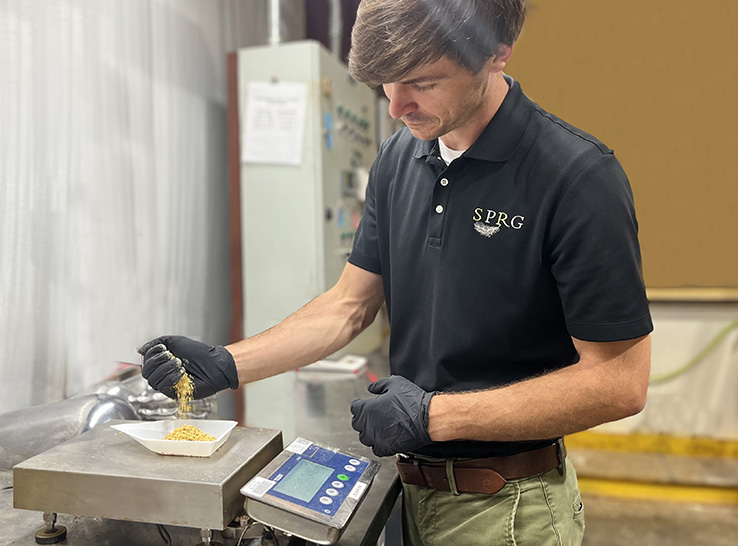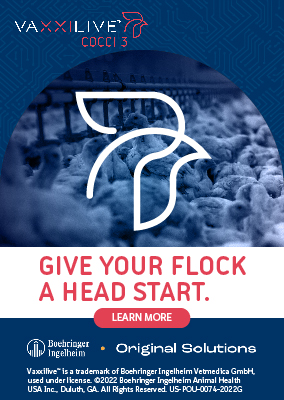Second in a two-part series
 Vaccines are essential tools for managing diseases in poultry and ensuring flock welfare. Taking shortcuts with them is never a good idea, however, and there’s plenty of research to prove it.
Vaccines are essential tools for managing diseases in poultry and ensuring flock welfare. Taking shortcuts with them is never a good idea, however, and there’s plenty of research to prove it.
In a recent interview, Bill Stanley, DVM, Boehringer Ingelheim, and Isabel Gimeno, DVM, PhD, North Carolina State University, talked about their experiences managing vaccines and ensuring optimum vaccine performance.
Q: Some commercial poultry operations dilute Marek’s disease (MD) vaccines to reduce vaccine costs. Does partial vaccine dosing affect protection against MD virus and immunosuppression?
Stanley: We certainly don’t recommend it. Giving a partial dose seriously diminishes the efficacy of the vaccine. The extent of the negative effect will, of course, depend on the level and pathogenicity of the challenge virus, the amount of dose reduction and the vaccine used.
When you reduce the recommended dose of vaccine, you’re making flocks more susceptible to MD virus and tumors. Because of the increasing incidence of immunosuppression, you would be putting your flock at risk.
Finally, you can expect an increased risk of a downturn in flock performance and lack of uniformity from variable or absent MD virus protection. Partial dosing is not an effective way to maximize your return on vaccine investment.
Gimeno: It’s important to understand that MD vaccines are cell-associated. When you use them, you are not just using viruses when vaccinating the birds. You are inoculating cells that are infected with the vaccine.
Most of the cells in a vaccine vial do not contain viruses — usually it’s less than 20%. Because of the cell-associated nature of the vaccines, chickens receive different doses — even if using the same vaccine vial.
In virology, we use plaque-forming units, or PFUs, to describe the number of virus particles capable of forming plaques per unit volume. The PFU numbers that the vaccine manufacturer provides is an average.
Q: Would you please provide an example?
Gimeno: Let’s say a vaccine batch has an average of 5,000 PFUs, but the doses might range from 1,500 to 7,000 PFUs. When that vaccine gets overdiluted, the lower range will be way below the minimum necessary to protect against MD virus. Therefore, there will be a percentage of chickens that will not receive an adequate dose of vaccine.
Another important concept is that each vaccine product requires a unique number of PFUs to achieve the maximum protection. We have demonstrated that some vaccines confer very good protection with average doses of 2,000 PFUs while others require more PFUs in order to achieve their maximum efficacy.
Finally, besides overdiluting, there are other factors that will further reduce your titers. Time is one of them. In less than an hour, reconstituting the vaccine titers will decrease at least 10% to 20%. Proper and frequent mixing of the vaccine is critical to reduce the variability of the administered dose. Adding antibiotics such as gentamicin to the vaccine can reduce titers 50%.
Several years ago, we conducted a study to evaluate the consequences of overdiluting MD vaccines when chickens were challenged with either a vvMDV) or a vv+MDV).
We demonstrated that if the challenge was vv+MDV, protection against tumors was very much reduced. Even when the challenge was vvMDV we detected poor performance and reduced bodyweight if the vaccine was overdiluted.
Q: Dr. Stanley, is that consistent with what you’re seeing in the field?
Stanley: Absolutely. As Dr. Gimeno has demonstrated in her research, underdosing can lead to reduced MD virus protection, reduced bodyweights and detrimental changes to vaccine viral DNA load.
Poultry clinicians need to carefully consider all production costs when making vaccine recommendations. Proper vaccine management — using the manufacturer’s recommended dose and following directions for proper storage, handling and administration — will provide the opportunity to maximize return on investment while protecting flocks against pathogenic MD and the effects of immunosuppression.
Gimeno: Our conclusions are based on field experience as well as research. My laboratory has done quite a few studies comparing partial and full dosing. The one I was referring to before was specifically done to study the effect of overdiluting vaccines, but we have done others.
For example, we evaluated protection conferred by several herpesvirus of turkey (HVT) vaccines (conventional and recombinant) at various doses. In all cases, reduced dosing affected protection against early challenge.
We have done similar studies with CVI988 and demonstrated that, depending on the product, the negative effect of partial dosing was more or less remarkable. But in all cases, protection was negatively affected when overdiluting the vaccine.
Q: MD virus vaccines may be administered in ovo or on day 1. Is one technique better than another?
Stanley: The age of the birds at MD vaccination may mean the difference between success and failure for an integrator because the birds will be challenged immediately in the field. Deciding the best age of vaccination depends on the level and type of MD virus challenge, the host immune health and other environmental factors.
In ovo vaccination stimulates immune-system maturation if an HVT vaccine is used. It also allows more time for the bird to develop immunity to MD virus than day-old vaccination. Other factors to consider between the two vaccine application methods are labor availability and egg hygiene.
Whether to use in ovo versus day-old vaccination should include input from the field veterinarian, production personnel, hatchery personnel and vaccine manufacturer’s technical team.
Gimeno: MD vaccines take 5 to 6 days to elicit an immune response. To ensure that vaccine can provide the maximum protection, it is critical that challenge does not occur in the first 5 to 6 days of age. This could be achieved by strong biosecurity programs that include thorough cleaning and disinfection between flocks.
In a survey that we conducted years ago in broiler chicken farms in the US, we detected oncogenic MD virus in 100% of the flocks as early as 7 days. This demonstrated that infection happens before the 5- to 6-day period. In those cases, in ovo vaccination would render better results than vaccination at day of age.
Another advantage of in ovo vaccination, as Dr. Stanley indicated, is that it hastens immunocompetence in the chickens, rendering chickens able to respond more efficiently not only to MD vaccines but also to other vaccines and pathogens.
With that said, for an in ovo vaccination to be effective the machines need to be properly maintained. That is also true for the subcutaneous vaccinators.
For more information on managing immunosuppression in poultry, contact william.stanley@boehringer-ingelheim.com or imgimeno@ncsu.edu.
In the first part of this interview, Drs. Stanley and Gimeno discussed the importance of managing immunosuppression in flocks challenged by Marek’s disease, infectious bursal disease and other conditions that can compromise immunity and undermine vaccine performance. Click here for more.
Editor’s note: Content on Modern Poultry’s Industry Insights pages is provided and/or commissioned by our sponsors, who assume full responsibility for its accuracy and compliance.









